Existing User Log In
New User Registration
Register for a free account to gain full access to the VGChartz Network and join our thriving community.



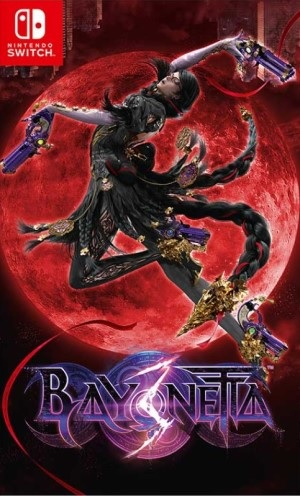

America - Front
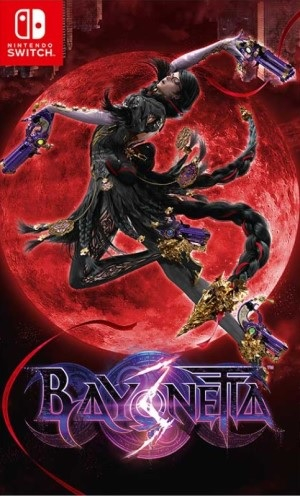

America - Back

PlatinumGames
Action
 10/28/22 Nintendo
10/28/22 Nintendo  (Add Date)
(Add Date) 10/28/22 Nintendo
10/28/22 Nintendo
| Owners: | 11 | |
| Favorite: | 1 | |
| Tracked: | 0 | |
| Wishlist: | 0 | |
| Now Playing: | 1 | |
Talk about a year for action games. What started looking like another rather barren year for the genre wound up carrying a solid slate of titles. Between Neon White, Soulstice, and even a Final Fantasy release, there’s been a lot to like in terms of games that put an emphasis on quick movement and fast combat. And what better way to potentially cap things off than with the latest title from Hideki Kamiya, arguably the father of the hack and slash genre. Nearly a decade since the launch of Bayonetta 2, the return of the promiscuous witch has to be something special… right?
The plot of Bayonetta 3 is a relatively simple affair when compared to the first two titles. After the opening cut scene depicts Bayonetta being rather inauspiciously killed by an unrevealed antagonist, series newcomer and witch-in-training Viola is forced to flee from her dimension in order to find a universe with a less-dead Bayonetta who can help out. That turns out to be us, and our Bayonetta departs to go on a tour of the multiverse and put a stop to the machinations of the main villain.
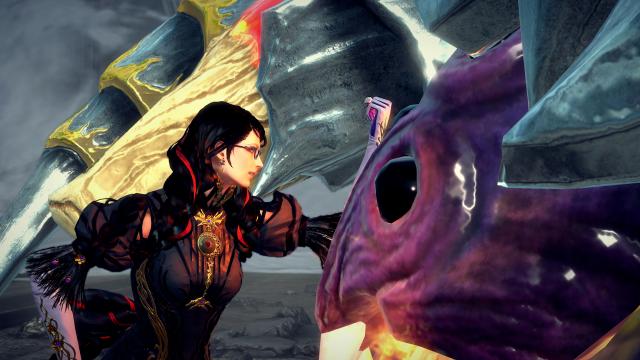
The story in Doctor Viola and the Multiverse of Bayonettas is actually quite separated from the events of 1 and 2, so if you’re a newcomer to the series or just had no idea what was going on in prior titles, then you won’t feel too left out. In a way, though, I wish it hadn’t been so disconnected. The plots of Bayonetta 1 and 2 focused squarely on the rivalry between Paradiso and Inferno, and aside from Bayonetta’s own summons those elements are pretty much entirely gone. It feels like the plot that would be used in a crossover game; primarily designed as an excuse to get Bayonetta to another world. Complaining about the story of all things in a Bayonetta game might seem like a pointless exercise, but I’d argue the setting and plot of the first two titles made them feel unique and stand out to some degree, especially when the alternative is co-opting the plot of a B-grade Marvel movie.
Fortunately, the characters do still steal the show. Getting to hang out again with the cast of this universe(s) and their unique and vibrant personalities is always a good time. Main cast aside, returning side characters like Rodin, Enzo, and Luka are still very much a treat to spend time with, the last of which has a surprising amount of prominence.
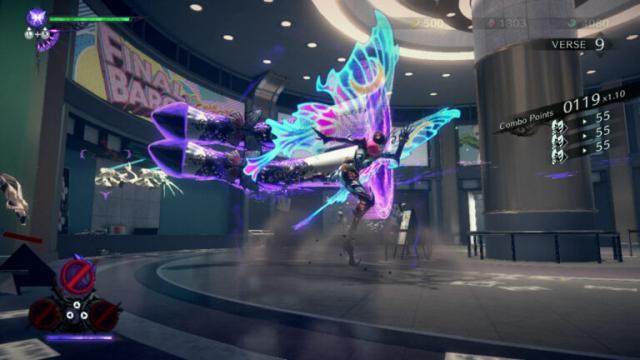
Gameplay is what counts, however, and in that respect Viola-Woman: Into the Bayoverse has to be examined on a couple of fronts. Bayonetta 3 introduces multiple playable protagonists in the main campaign for the first time (excluding a few mid-mission set pieces in prior games), which necessitates looking at each character individually. Bayonetta returns as the primary focus and controls pretty similarly to her prior incarnations, with a few notable twists. First is that you can no longer equip different weapons on Bayonetta's hands and feet. Weapon switching is now limited to two weapons at a time rather than two sets of two weapons apiece, which does impose a tad on player creativity. Umbral Climax from Bayonetta 2 is also gone, and torture attacks no longer work on a magic meter as before.
So what does the magic meter do now, then? It fuels Bayonetta’s infernal summons, which are now a standard gameplay mechanic instead of simply functioning as set pieces or end-of-fight cut scene material. At pretty much any time you can summon a demon to fight in battle, at which point the game swaps to you controlling the summon instead of Bayonetta. I’m not a huge fan of this mechanic - Bayonetta’s summons do vary in speed and strength, but they’re all much bulkier, slower, and more unwieldy than Bayonetta herself. And interrupting a fast-paced action game to pull out a giant monster so we can have a slower-paced punch up, like I'm controlling King Kong lumbering around a battlefield, feels more like an unwanted interruption than a fun change of pace.
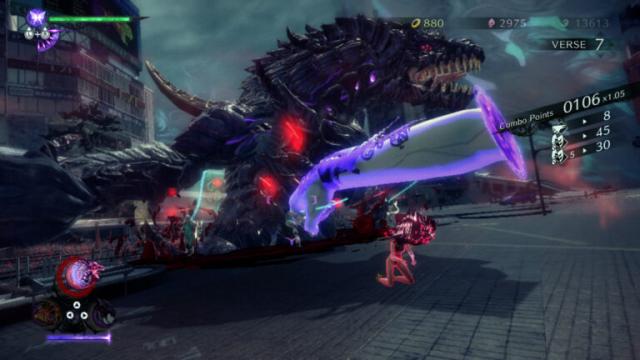
Granted, using these summons is optional for the most part; I found myself using them less and less frequently as time went by. That said, it’s still a shame that other mechanics have been ignored or even slimmed down to make way for this. It feels like most of the changes to Bayonetta’s moveset in this game were done to make her look cool, rather than actually make the gameplay more complex or interesting. Platinum hasn’t done much to improve on Bayonetta’s core combat since the original Bayonetta in 2009, and while that was and still remains very entertaining to play with, I think this sequel would have benefitted a lot more from expanding Bayonetta's core toolkit with increased movelists for weapons.
The other side of the coin is newcomer Viola, whose inclusion instantly drew comparisons to Nero's introduction in DMC 4 when she was revealed. And it does make a bit of sense, as both characters possess a somewhat simpler moveset compared to the returning series protagonist. Unlike Bayonetta, she only has one weapon at her disposal: a very large katana. Fortunately, like Nero, she remains entertaining despite the seemingly simpler nature of her combat.
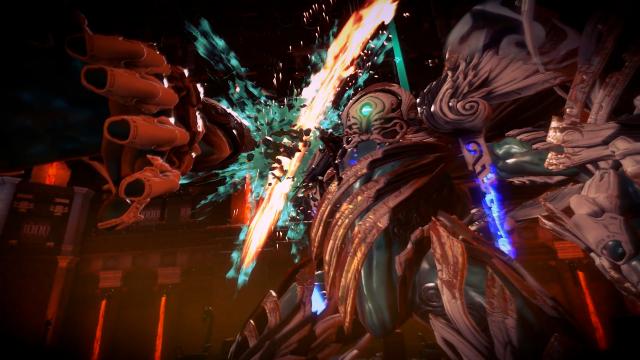
A lot of this comes from how Viola’s mechanics function. To start off, unlike Bayonetta, her dodge cannot trigger witch time. Viola possesses a unique parry mechanic all to her own, which requires players to stand their ground and block with what feels like more precise timing. Her singular infernal summon, Cheshire, also works differently: rather than being a static summon that takes control away from the player, Cheshire is controlled by the AI, leaving the player to continue controlling Viola. It makes him feel more like a natural contributor to combat rather than an entity trying to replace the protagonist.
By the end of the game I found myself enjoying Viola more than Bayonetta, which makes the level breakdown feel a bit disappointing, at least for me. Out of the 14 combat missions (plus 2 prologue/tutorial segments), Viola is only playable in 3. That said, you unlock additional challenge stages that can be played as anyone after completion, so there are plenty of ways to hop in and play as whoever you like.
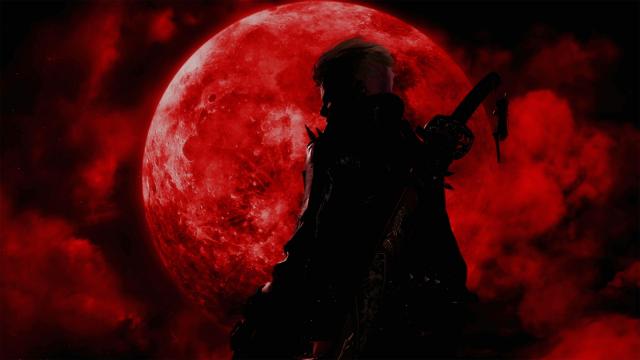
Ultimately, the multiple protagonists approach lands well for me. I think Viola’s brute-strength approach contrasts well with Bayonetta’s more graceful style of combat, and presents an interesting character dynamic that is quite engaging. As someone who will likely sink a lot of hours into experimenting with the various abilities available to both characters, it’s nice to have two very distinct characters to play as, but even if you don’t anticipate playing Bayonetta Everywhere All at Once multiple times, there’s just enough familiarity between the two characters to make switching back and forth an easy process.
General combat and enemy design feels improved from 1 and 2. After fighting angels exclusively in 1, and both angels and demons in 2, it’s fitting that we’ve now added man-made enemies to the mix, and to Bayonetta 3’s credit, there’s a much greater emphasis on clarity over spectacle this time around. Prior games had a tendency to occasionally devolve into encounters with exceptionally elaborate backgrounds or floating backdrops that looked impressive but made it very difficult to gauge spacing and whether an incoming projectile was an enemy attack or part of the scenery. Arenas are now much more cleanly designed, and enemy attacks feel much more easily identifiable and reactable as well; there’s less memorization required to consistently witch time (or parry) attacks.
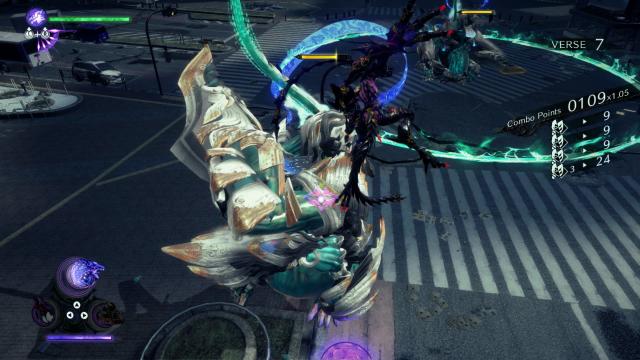
Having said that, I feel Bayonetta 3 suffers heavily from bloating itself around nearly everything that isn't its combat. The Bayonetta series, like most Platinum games, loves its set pieces. And, usually speaking, I like them too, as long as they’re fast, entertaining, and don’t outstay their welcome. While a lot of the set pieces here do fit that description, there are many that simply don’t. There are quite a few small, simple puzzle elements that involve standing in a magic circle and slowly guiding an infernal summon around to press some switches in order to open a door, as well as some very weird one-off sequences, like having to run around a small desert area as Cheshire searching for water.
The most egregious examples, however, are the end-of-mission Kaiju fights that you're occasionally thrown into. Every so often Bayonetta will run into the game’s main antagonist (or, at least, him possessing a giant creature), and she’ll have to summon a supercharged version of one of her normal summons to engage in a very slow and drawn-out fight with the villain. And it sucks. It feels like something out of the god-awful Godzilla game from 2015. It’s slow, boring, and robs what should be the grand finale of an epic encounter of all the energy and momentum it should have.
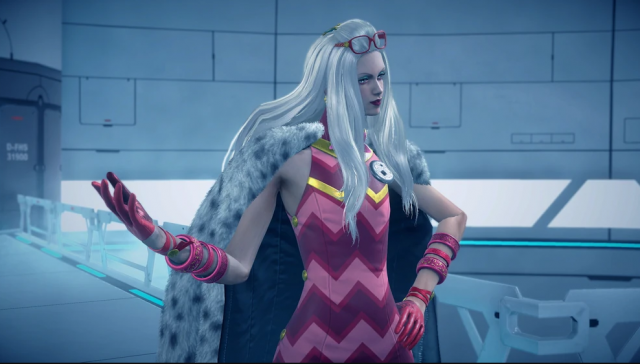
Another very odd addition is the inclusion of Jeanne “spy mission” segments. Every few chapters you just stop playing an action game entirely and take control of Jeanne for some sidescrolling stealth missions. They’re not particularly hard or annoying, especially since you can pretty much just ignore them on repeat playthroughs, but they’re also not really fun or interesting either. They’re just kind of… there. If we’re really struggling this hard to find stuff for Jeanne to do, could we just give her her own unique moveset and make her part of the main campaign?
Aesthetically Bayonetta 3 is mostly serviceable. The framerate is an issue more consistently than I’d like it to be, likely due to the Switch’s limited power. Environmental design feels less memorable than the Venetian architecture of the first two titles, although that is probably a result of the game switching dimensions so frequently. On the other hand, the combat animations are absolutely beautiful and both Bayonetta and Viola look great while fighting. The sound design is great all around. After all the dust has settled and the accusations have faded away, Jennifer Hale did an absolutely spectacular job as Bayonetta, and Anna Brisbin is great as Viola too. Music remains a highlight of the series too, with both of the main protagonists getting fantastic combat themes.
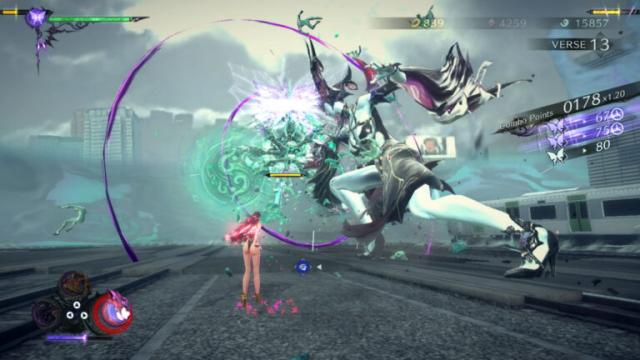
One final element I want to address is the ending, and I'll put a big fat spoiler warning here even though I will try to keep my comments relatively free of major details. I don't usually take a separate paragraph from the story to address the ending exclusively, especially for a series like Bayonetta, which is already fairly light on story, but I wanted to on this occasion because the ending is really bad. Like Mass Effect 3 levels of awfulness. Without wishing to give too much away, this at least appears to be a farewell for Bayonetta (and indeed most of the supporting cast we've gotten to know over the past two titles), and while I'm not opposed to authors writing a conclusive end for tenured characters, the ending provided here is thoroughly unsatisfying and doesn't have anywhere near the setup needed for the payoff the game was trying to achieve. Again, I know Bayonetta has never been a story-heavy series, but a beloved character like Bayonetta deserved a much better send-off.
Overall, I’m left somewhat uncertain what to make of Bayonetta 3. I’ve certainly enjoyed my time with it so far, and will continue to do so while hunting for Platinum medals and messing around in Witch Trials. The core combat is still really fun, even if Bayonetta’s gameplay probably doesn’t feel like it’s pushing itself as far as it could. That said, there are too many things that try to steal the show that aren't as enjoyable as the combat. Summons don’t add as much to the combat as they should for how large of a role they occupy, and the abundance of set pieces and side activities only serve to slow down what should be a non-stop thrill ride. The fact that the story is largely a generic multiverse plot with an immensely unsatisfying ending leaves me walking away with a somewhat bitter taste in my mouth for what was one of my most anticipated games coming into 2022, even if I still largely enjoyed most of my time with it. Bayonetta 3 ultimately feels like a solid action game, but not one that was worth waiting eight years for.









